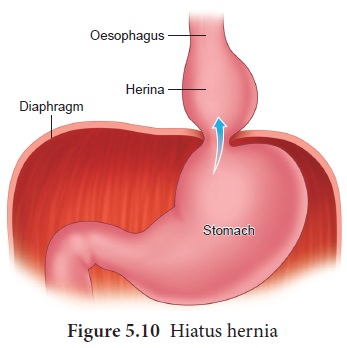Chapter: 11th Zoology : Chapter 5 : Digestion and Absorption
Nutritional and digestive disorders
Nutritional
and digestive disorders
Intestinal
tract is more prone to bacterial, viral and parasitic worm infections. This
infection may cause inflammation of the inner lining of colon called colitis.
The most common symptoms of colitis are rectal bleeding, abdominal cramps, and
diarrhoea.
Protein energy malnutrition: (PEM)
Growing
children require more amount of protein for their growth and development.
Protein deficient diet during early stage of children may lead to protein
energy malnutrition such as Marasmus and
Kwashiorkor. Symptoms are dry skin, pot-belly, oedema in
the legs and face, stunted growth, changes in hair colour, weakness and
irritability. Marasmus is an acute form of protein malnutrition. This condition
is due to a diet with inadequate carbohydrate and protein. Such children are
suffer from diarrhoea, body becomes lean and weak (emaciated) with reduced fat
and muscle tissue with thin and folded skin.
Indigestion: It is a digestive disorder in
which the food is not properly digested leading
to a feeling of fullness of stomach. It may be due to inadequate enzyme
secretion, anxiety, food poisoning, over eating, and spicy food.
Constipation: In this condition, the faeces are
retained within the rectum because of irregular
bowel movement due to poor intake of fibre in the diet and lack of physical
activities.
Vomiting: It is reverse peristalsis.
Harmful substances and contaminated food from stomach are ejected through the mouth. This action is controlled
by the vomit centre located in the medulla oblongata. A feeling of nausea
precedes vomiting.
Jaundice: It is the condition in which
liver is affected and the defective liver fails to break down haemoglobin and to remove bile pigments from the blood.
Deposition of these pigments changes the colour of eye and skin yellow.
Sometimes, jaundice is caused due to hepatitis viral infections.
Liver cirrhosis: Chronic disease of liver results
in degeneration and destruction of
liver cells resulting in abnormal blood vessel and bile duct leading to the
formation of fibrosis. It is also called deserted liver or scarred liver. It is
caused due to infection, consumption of poison, malnutrition and alcoholism.
Gall Stones: Any alteration in the composition
of the bile can cause the formation of stones
in the gall bladder. The stones are mostly formed of crystallized cholesterol
in the bile. The gall stone causes obstruction in the cystic duct, hepatic duct
and also hepato-pancreatic duct causing pain, jaundice and pancreatitis.
Appendicitis: It is the inflammation of the
vermiform appendix, leading to severe abdominal
pain. The treatment involves the removal of appendix by surgery. If treatment
is delayed the appendix may rupture and results in infection of the abdomen,
called peritonitis.
Hiatus hernia (Diaphragmatic hernia): Itisastructuralabnormalityinwhichsuperior part of the stomach protrudes-
slightly above the diaphragm. The exact cause of hiatus hernias
is not known. In some people, injury or other damage may weaken muscle tissue,
by applying too much pressure (repeatedly) on the muscles around the stomach
while coughing, vomiting, and straining during bowel movement and lifting heavy
object. Heart burn is also common in those with a hiatus hernia. In this
condition, stomach- contents travel back into the oesophagus or even into oral
cavity and causes pain in the centre of the chest due to the eroding nature of
acidity (Figure-.5.10).
Diarrhoea: It is the most common
gastrointestinal disorder worldwide. It is
sometimes caused by bacteria or viral infections through food or water.
When the colon is infected, the lining of the intestine is damaged by the
pathogens, thereby the colon is unable to absorb fluid. The abnormal frequency
of bowel movement and increased liquidity of the faecal discharge is known as
diarrhoea. Unless the condition is treated, dehydration can occur. Treatment is
known as oral hydration therapy.
This involves drinking plenty of fluids – sipping small amounts of water at a
time to rehydrate the body.

Peptic ulcer: It refers to an eroded area of
the tissue lining (mucosa) in the stomach or duodenum. Duodenal ulcer occurs in people in the age group of 25 -
45 years. Gastric ulcer is more common in persons above the age of 50 years.
Ulcer is mostly due to infections caused by the bacterium Helicobacter pylori. It
may also be caused due to uncontrolled usage of aspirin or certain
antiinflammatory drugs. Ulcer may also be caused due to smoking, alcohol,
caffeine and psychological stress.
Obesity: It is
caused due to the storage of excess of body fat in adipose tissue. It may induce hypertension, atherosclerotic
heart disease and diabetes. Obesity may be genetic or due to excess intake of
food, endocrine and metabolic disorders. Degree of obesity is assessed by body
mass index (BMI). A normal BMI range
for adult is 19-25; above 25 is considered as obese. BMI is calculated as body
weight in Kg, divided by the square of body height in meters. For example, a 50
Kg person with a height of 160 cms would have a BMI of 19.5.
That is
BMI = 50/1.62 = 19.5
Related Topics